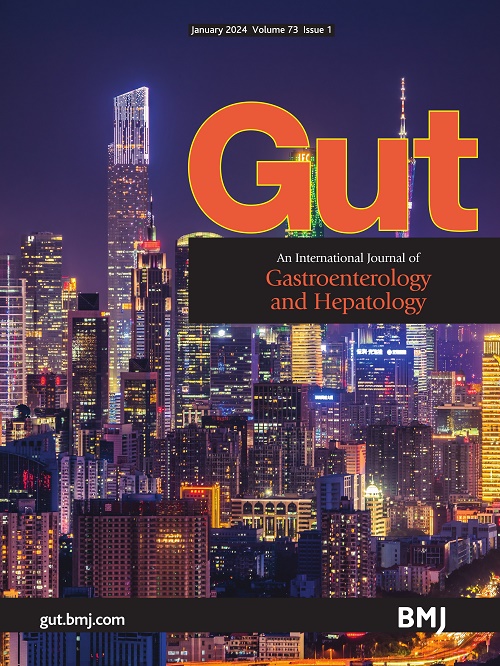Margin thermal ablation eliminates size as a risk factor for recurrence after piecemeal endoscopic mucosal resection of large non-pedunculated colorectal polyps
IF 23
1区 医学
Q1 GASTROENTEROLOGY & HEPATOLOGY
引用次数: 0
Abstract
Background Lesion size is an independent risk factor for recurrence following endoscopic mucosal resection of large (≥20 mm) non-pedunculated colorectal polyps. Post-resection margin thermal ablation (MTA) reduces the risk of recurrence. Its impact on the uncommon larger (≥40 mm) lesions is unknown. Objective We sought to analyse the impact of MTA on ≥40 mm lesions in a large, prospective cohort. Design A prospective cohort of patients with colorectal polyps ≥20 mm treated with piecemeal endoscopic mucosal resection in an expert tissue resection centre was divided into three phases: ‘pre-MTA’, July 2009–June 2012; ‘MTA-adoption’, July 2012–June 2017 and ‘standardised-MTA’, July 2017–July 2023. Recurrence was defined as adenomatous tissue endoscopically and/or histologically detected at the first surveillance colonoscopy. The primary outcome was the recurrence rate over the three time periods in three size groups: 20–39 mm, 40–59 mm and ≥60 mm. Results Over 14 years until July 2023, 1872 sporadic colorectal polyps ≥20 mm in 1872 patients underwent endoscopic mucosal resection (median lesion size 35 mm (IQR 25–45mm)). Of these, 1349 patients underwent surveillance colonoscopy at a median of 6 months (IQR 4–8 months). The overall rates of recurrence in the pre-MTA, MTA-adoption and standardised-MTA phases were 13.5% (n=42/310), 12.6% (n=72/560) and 2.1% (n=10/479), respectively, (p≤0.001). When MTA was applied in the standardised-MTA phase, the rate of recurrence was the same among 20–39 mm (1.5% (3/205)), 40–59 mm (1.6% (3/190)) and ≥60 mm polyps (1.4% (1/73)) (p=1.00). Conclusion MTA negates the effect of size on the incidence of recurrence after piecemeal endoscopic mucosal resection of colorectal polyps ≥40 mm. Trial registration number Australian Colonic Endoscopic Resection cohort ([NCT01368289][1]; [NCT02000141][2]). Data are available upon reasonable request. [1]: /lookup/external-ref?link_type=CLINTRIALGOV&access_num=NCT01368289&atom=%2Fgutjnl%2Fearly%2F2025%2F03%2F05%2Fgutjnl-2024-333563.atom [2]: /lookup/external-ref?link_type=CLINTRIALGOV&access_num=NCT02000141&atom=%2Fgutjnl%2Fearly%2F2025%2F03%2F05%2Fgutjnl-2024-333563.atom边缘热消融消除了大小作为内镜下大片无带蒂结肠直肠息肉切除术后复发的危险因素
背景:病变大小是内镜下大(≥20mm)无带蒂结直肠息肉切除术后复发的独立危险因素。切除后边缘热消融(MTA)可降低复发风险。它对不常见的较大(≥40 mm)病变的影响尚不清楚。目的:在一个大型前瞻性队列中,我们试图分析MTA对≥40 mm病变的影响。设计一项前瞻性队列研究,对≥20 mm的结肠息肉患者在专家组织切除中心行分段内镜粘膜切除术,分为三个阶段:“mta前”,2009年7月- 2012年6月;“mta采用”,2012年7月- 2017年6月;“标准化mta”,2017年7月- 2023年7月。复发定义为在第一次结肠镜检查和/或组织学检查中发现腺瘤组织。主要终点是三个尺寸组(20 - 39mm, 40 - 59mm和≥60mm)三个时间段的复发率。结果截至2023年7月的14年间,1872例≥20 mm的散发性结直肠息肉患者行内镜下粘膜切除术(病灶中位大小35 mm (IQR 25-45mm))。其中,1349例患者在中位6个月(IQR 4-8个月)时接受了结肠镜检查。mta前期、mta采用期和标准化mta期的总复发率分别为13.5% (n=42/310)、12.6% (n=72/560)和2.1% (n=10/479),差异有统计学意义(p≤0.001)。在标准化MTA期应用MTA时,20-39 mm(1.5%(3/205))、40-59 mm(1.6%(3/190))和≥60 mm(1.4%(1/73))息肉的复发率相同(p=1.00)。结论MTA对≥40 mm的结直肠息肉内镜下粘膜切片切除术后复发率无影响。试验注册号:澳大利亚结肠内镜切除队列([NCT01368289][1];[NCT02000141][2])。如有合理要求,可提供资料。[1]: /查找/ external-ref ? link_type = CLINTRIALGOV&access_num = NCT01368289&atom = % 2 fgutjnl % 2恐惧% 2 f2025 % 2 f03 % 2 f05 % 2 fgutjnl - 2024 - 333563。link_type=CLINTRIALGOV&access_num=NCT02000141&atom=%2Fgutjnl% 2F2025%2F03%2F05%2Fgutjnl-2024-333563.atom
本文章由计算机程序翻译,如有差异,请以英文原文为准。
求助全文
约1分钟内获得全文
求助全文
来源期刊

Gut
医学-胃肠肝病学
CiteScore
45.70
自引率
2.40%
发文量
284
审稿时长
1.5 months
期刊介绍:
Gut is a renowned international journal specializing in gastroenterology and hepatology, known for its high-quality clinical research covering the alimentary tract, liver, biliary tree, and pancreas. It offers authoritative and current coverage across all aspects of gastroenterology and hepatology, featuring articles on emerging disease mechanisms and innovative diagnostic and therapeutic approaches authored by leading experts.
As the flagship journal of BMJ's gastroenterology portfolio, Gut is accompanied by two companion journals: Frontline Gastroenterology, focusing on education and practice-oriented papers, and BMJ Open Gastroenterology for open access original research.
 求助内容:
求助内容: 应助结果提醒方式:
应助结果提醒方式:


